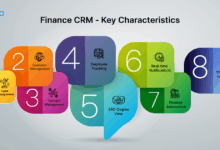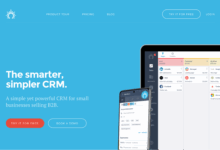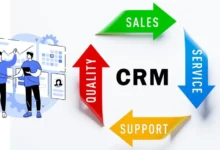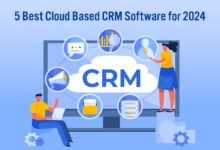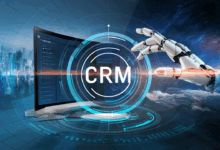CRM Software for Small Business Success
CRM Software for Small Business offers a transformative path to streamlined operations and enhanced customer relationships. Effectively managing customer interactions is crucial for growth, and a well-chosen CRM system can provide the tools to achieve this. This guide explores the selection, implementation, and optimization of CRM solutions tailored to the unique needs of small businesses, from identifying essential features to maximizing return on investment.
We’ll delve into the various types of CRM software available, comparing cloud-based and on-premise options, and examining how different pricing tiers cater to various budgets and business scales. Furthermore, we’ll address the crucial aspects of data management, analysis, and integration with other business tools to ensure a seamless and effective workflow. Ultimately, our goal is to empower small businesses to leverage CRM technology to improve efficiency, boost sales, and foster lasting customer loyalty.
Defining Needs for Small Business CRM
Choosing the right CRM can significantly impact a small business’s growth and efficiency. A well-integrated system streamlines operations, improves customer relationships, and ultimately boosts profitability. Understanding the specific needs of your business is crucial before selecting a CRM solution.
Essential features for a small business CRM include contact management (with robust search and filtering capabilities), lead tracking and management, sales pipeline visualization, basic reporting and analytics, and ideally, integration with other business tools like email marketing platforms and accounting software. The system should be user-friendly and intuitive, requiring minimal training to use effectively.
CRM Needs Across Different Small Business Types
Different business models have varying CRM requirements. Retail businesses, for instance, prioritize inventory management integration, point-of-sale (POS) system connectivity, and detailed customer purchase history tracking. Service-based businesses, conversely, focus on scheduling and appointment management, service history tracking for each client, and potentially project management capabilities. E-commerce businesses require strong integration with their online store, order management features, and detailed customer interaction tracking across various online channels.
Scalability in Small Business CRM
Scalability is paramount for a small business CRM. As the business grows, the CRM should be able to adapt and accommodate increasing data volumes, more users, and potentially more complex features. Choosing a cloud-based CRM offers inherent scalability, allowing the business to easily upgrade its plan as needed without significant upfront investment or complex technical upgrades. Conversely, on-premise solutions may require costly upgrades and technical expertise to accommodate growth.
Hypothetical Scenario: Benefits of CRM Implementation
Imagine a small bakery, “Sweet Success,” struggling to manage its growing customer base. They use spreadsheets and handwritten notes to track orders, customer preferences, and loyalty program details. This leads to inconsistencies, missed opportunities, and inefficient customer service. Implementing a CRM allows Sweet Success to centralize customer information, automate marketing campaigns (e.g., birthday emails with special offers), track customer purchase history to personalize recommendations, and efficiently manage online and in-store orders. The result is improved customer satisfaction, increased repeat business, and a more efficient operational workflow, leading to increased profitability and a more streamlined business.
Exploring CRM Software Options
Choosing the right CRM software can significantly impact a small business’s efficiency and growth. The market offers a wide array of options, each with its own strengths and weaknesses, making the selection process crucial. Understanding the different pricing models, features, and deployment methods is key to making an informed decision.
Popular CRM Software Options for Small Businesses
Several CRM software solutions cater specifically to the needs and budgets of small businesses. These options are often categorized by pricing tiers, allowing businesses to choose a system that aligns with their financial capabilities and anticipated usage.
Free/Freemium Options: These typically offer limited functionality but provide a good starting point for smaller businesses with basic needs. Examples include HubSpot CRM (free plan with paid upgrades), Zoho CRM (free plan with limitations), and Bitrix24 (free plan with paid features).
Affordable Options (Under $50/user/month): This tier provides a broader range of features, often including contact management, basic sales automation, and reporting capabilities. Examples include Freshsales, Agile CRM, and Keap (formerly Infusionsoft).
Mid-Range Options ($50-$150/user/month): These systems usually offer more advanced features like marketing automation, advanced reporting and analytics, and integrations with other business tools. Examples include Salesforce Essentials, Pipedrive, and Zoho CRM (paid plans).
Enterprise Options (Over $150/user/month): These are comprehensive solutions designed for larger organizations with complex needs and often include features like advanced customization, robust security, and dedicated support. Examples include Salesforce Sales Cloud and Microsoft Dynamics 365.
Comparison of Three CRM Software Packages
Let’s compare three popular CRM systems across different pricing tiers: HubSpot CRM (Freemium), Zoho CRM (Affordable/Mid-Range), and Salesforce Essentials (Mid-Range).
HubSpot CRM (Freemium): Strengths include its user-friendly interface, robust free plan, and strong integration with other HubSpot marketing tools. Weaknesses include limitations in the free plan, potentially requiring upgrades for full functionality. Its free plan may not suit businesses with many contacts or complex sales processes.
Zoho CRM (Affordable/Mid-Range): Strengths include its comprehensive feature set across various pricing tiers, affordability, and good customization options. Weaknesses might include a slightly steeper learning curve compared to HubSpot and potential limitations in advanced analytics on lower-tier plans. It offers a good balance of features and price, making it suitable for growing businesses.
Salesforce Essentials (Mid-Range): Strengths include its powerful features, strong brand reputation, and excellent scalability. Weaknesses include a higher price point and a potentially steeper learning curve than other options. It’s a solid choice for businesses that need robust features and are willing to invest accordingly. It may be overkill for businesses with very simple needs.
Cloud-Based vs. On-Premise CRM Solutions
Cloud-based CRM systems store data on remote servers, accessible via the internet. On-premise CRM solutions require the installation and maintenance of software on a company’s own servers.
Cloud-Based CRM: Advantages include accessibility from anywhere with an internet connection, reduced IT infrastructure costs, automatic updates, and scalability. Disadvantages include reliance on internet connectivity, potential security concerns (though reputable providers have robust security measures), and potential vendor lock-in.
On-Premise CRM: Advantages include greater control over data security and customization, and no reliance on internet connectivity. Disadvantages include higher upfront costs, the need for dedicated IT infrastructure and personnel for maintenance and updates, and limited accessibility.
Features of Five Different CRM Systems
The following table summarizes key features of five different CRM systems, highlighting their pricing and target user base.
| Software Name | Key Features | Pricing | Target User |
|---|---|---|---|
| HubSpot CRM | Contact management, deal tracking, email integration, basic reporting, marketing automation (paid plans) | Freemium to Enterprise | Small to medium businesses |
| Zoho CRM | Contact management, sales automation, workflow automation, analytics, mobile access | Freemium to Enterprise | Small to large businesses |
| Salesforce Essentials | Contact management, opportunity management, sales forecasting, reporting, mobile access | Mid-range to Enterprise | Small to medium businesses |
| Freshsales | Contact management, sales automation, email integration, predictive lead scoring, mobile access | Affordable to Mid-range | Small to medium businesses |
| Pipedrive | Deal management, sales pipeline visualization, email integration, reporting, mobile access | Affordable to Mid-range | Sales-focused small to medium businesses |
Implementation and Integration
Successfully implementing a CRM system is crucial for reaping its benefits. A well-planned rollout minimizes disruption and maximizes user adoption, leading to improved efficiency and data-driven decision-making. This process involves careful planning, execution, and ongoing support.
The implementation of a CRM system in a small business is a phased process requiring careful consideration and execution. It’s not simply a matter of installing software; it’s about integrating the system into the existing workflow and ensuring its effective use by all employees.
Data Migration and Cleaning
Data migration is the process of transferring existing customer and business data from legacy systems (spreadsheets, databases, etc.) into the new CRM. Data cleaning involves identifying and correcting inconsistencies, inaccuracies, and duplicates within this data. This is critical because inaccurate data renders the CRM ineffective. Imagine trying to analyze sales trends with inconsistent contact information or duplicated customer records – it’s impossible to draw meaningful conclusions. A thorough data cleansing process ensures the integrity of the information within the CRM, forming a reliable foundation for future analysis and reporting. This often involves standardizing data formats, removing duplicates, and filling in missing information. For example, ensuring all phone numbers are in a consistent format (e.g., +1 (XXX) XXX-XXXX) and correcting spelling errors in customer names are key parts of this process.
Employee Training
Effective employee training is paramount for successful CRM adoption. Without proper training, employees may resist using the new system, leading to underutilization and a poor return on investment. Training should be tailored to different roles and skill levels, focusing on practical application rather than technical details. Consider a blended approach, combining online tutorials with hands-on workshops and ongoing support. For instance, sales representatives might focus on lead management and opportunity tracking, while customer service representatives would focus on case management and communication tools. Regular refresher sessions and readily available support materials (FAQs, videos, cheat sheets) are essential for long-term success.
CRM System Integration
Integrating the CRM with other business tools significantly enhances its value. Connecting the CRM to email marketing platforms allows for targeted campaigns and personalized communication. Linking it with accounting software streamlines invoicing, payment processing, and financial reporting. For example, integrating with Mailchimp allows for automated email sequences triggered by CRM events (e.g., a new lead, a customer purchase). Similarly, integration with Xero or QuickBooks provides a real-time view of customer financial data within the CRM, providing a holistic view of customer interactions and financial performance. This integration minimizes data entry duplication and improves overall data accuracy and accessibility. Consider the potential benefits of integration with other tools like project management software or social media platforms, depending on your business needs.
Data Management and Analysis within CRM
Effective data management and analysis are crucial for leveraging the full potential of a CRM system. A well-organized CRM database provides valuable insights into customer behavior, sales trends, and overall business performance, enabling data-driven decision-making for improved efficiency and profitability. This section will outline key aspects of data management and analysis within a small business CRM context.
Sample Data Entry Procedure
Consistent and accurate data entry is paramount for reliable analysis. A typical data entry procedure for a small business might involve the following steps: First, immediately after a customer interaction (e.g., phone call, email, meeting), the relevant details are recorded. This includes the customer’s name, contact information, interaction details (date, time, subject), and any relevant notes or actions agreed upon. Second, this information is entered into the CRM system, ensuring accuracy and completeness. Finally, the entry is reviewed for accuracy and completeness before saving. For instance, if a customer placed an order, the order details, including products, quantities, and payment method, would also be recorded. Regular data cleaning and validation procedures should also be implemented to maintain data integrity.
Tracking Sales Performance and Identifying Areas for Improvement
CRM data offers a comprehensive view of sales performance. By analyzing sales data such as revenue generated per customer, sales cycle length, conversion rates, and win/loss ratios, businesses can pinpoint areas needing attention. For example, if the conversion rate from lead to sale is low, the sales process might need refinement. Similarly, consistently long sales cycles could indicate inefficiencies in the sales pipeline. Analyzing individual salesperson performance alongside these overall metrics provides valuable insights into individual strengths and weaknesses, facilitating targeted coaching and training. This data-driven approach allows for proactive improvements rather than reactive problem-solving.
Generating Reports to Visualize Key Performance Indicators (KPIs)
Most CRM systems provide reporting capabilities to visualize KPIs. These reports can showcase various metrics, including sales revenue, customer acquisition cost, customer lifetime value, and customer churn rate. A visual representation, such as charts and graphs, facilitates a quick understanding of trends and patterns. For example, a line graph displaying monthly sales revenue can quickly identify seasonal variations or periods of growth and decline. Similarly, a bar chart comparing the performance of different sales representatives can highlight top performers and those needing additional support. Regularly reviewing these reports enables proactive adjustments to sales strategies and resource allocation.
Segmenting Customer Data for Targeted Marketing Campaigns
Effective segmentation allows for targeted marketing campaigns. Customer data within the CRM can be segmented based on various criteria, such as demographics (age, location, gender), purchase history (products purchased, frequency of purchase, spending amount), and engagement level (website visits, email opens, social media interactions). For instance, customers who have frequently purchased a specific product can be targeted with promotions on related items. Customers who haven’t engaged with the business recently might receive a reactivation email campaign. This targeted approach maximizes marketing ROI by focusing resources on the most promising customer segments.
Customer Relationship Management Strategies
A well-implemented CRM system is not just a database; it’s a powerful tool for building and nurturing customer relationships. Effective strategies leverage the system’s capabilities to enhance customer satisfaction, boost retention, and ultimately drive business growth. By understanding and implementing these strategies, small businesses can significantly improve their bottom line and build a loyal customer base.
Successful CRM implementation requires a proactive approach to customer interaction and data analysis. This involves utilizing the CRM’s features to personalize communication, track customer preferences, and anticipate their needs. By actively engaging with customers and using the insights gained from CRM data, businesses can foster stronger relationships and improve customer lifetime value.
Improving Customer Satisfaction through CRM
CRM systems provide several avenues for enhancing customer satisfaction. Real-time access to customer history allows for personalized service, addressing individual needs promptly and efficiently. For example, a small bakery using CRM could track customer preferences for specific pastries or dietary restrictions, ensuring they receive tailored recommendations and avoid any potential allergic reactions. Furthermore, efficient case management within the CRM streamlines issue resolution, reducing customer wait times and improving their overall experience. Regular feedback mechanisms integrated into the CRM, such as post-purchase surveys, allow businesses to proactively address concerns and continuously improve their services.
Examples of Personalized Customer Communication
Personalized communication is key to building strong customer relationships. CRM systems facilitate this by enabling targeted marketing campaigns based on customer segmentation. Imagine a clothing boutique using CRM to identify customers who frequently purchase dresses. The CRM could then automatically send them email notifications about new dress arrivals or exclusive discounts on similar items. Similarly, automated birthday emails with personalized offers or loyalty program updates create a sense of appreciation and build brand loyalty. This targeted approach enhances customer engagement and improves the overall customer experience compared to generic, mass marketing campaigns.
Enhancing Customer Retention Efforts with CRM
Customer retention is crucial for long-term business success. CRM systems provide valuable tools for achieving this. By tracking customer interactions, businesses can identify at-risk customers—those who haven’t made a purchase in a while or have expressed dissatisfaction. Proactive outreach, such as personalized emails offering incentives or addressing specific concerns, can help re-engage these customers. Furthermore, CRM’s reporting features allow businesses to analyze customer churn rates, identifying trends and potential issues that contribute to customer loss. This data-driven approach enables proactive interventions and improvements to customer service strategies, ultimately reducing churn and increasing retention.
The Role of CRM in Building Strong Customer Relationships
A CRM system serves as the central hub for all customer interactions, providing a holistic view of each customer’s journey. This 360-degree perspective allows businesses to understand customer needs and preferences better, fostering stronger relationships. For instance, a small consulting firm using CRM can track client projects, communication history, and feedback, enabling them to provide more tailored and effective services. By consistently exceeding customer expectations and demonstrating genuine care, businesses build trust and loyalty, leading to increased customer lifetime value and positive word-of-mouth referrals. The CRM system facilitates this process by providing the necessary tools and data to personalize interactions and build lasting relationships.
Cost and Return on Investment (ROI)
Investing in CRM software requires careful consideration of costs and potential returns. Understanding the various expense factors and employing effective ROI calculation methods is crucial for small businesses to make informed decisions and maximize their investment. This section will explore the financial aspects of CRM implementation, providing a framework for evaluating its profitability.
Cost Factors Associated with CRM Software
The total cost of ownership for CRM software extends beyond the initial licensing fee. Several key cost factors must be considered for accurate budgeting and financial planning. These factors significantly influence the overall financial implications of CRM adoption.
- Licensing Fees: This is the recurring cost for using the CRM software, typically charged monthly or annually, based on the number of users and chosen features. Pricing models vary widely, from per-user subscriptions to tiered packages offering different functionalities.
- Implementation Costs: This encompasses the time and resources required to set up the CRM system, including data migration, customization, and initial configuration. Depending on the complexity of the implementation, this can involve internal staff time or the engagement of external consultants, significantly impacting the overall cost.
- Training Costs: Proper training for staff is essential for effective CRM utilization. Costs associated with training can include internal training sessions, external training courses, or online tutorials. The effectiveness of training directly correlates with the successful adoption and ROI of the CRM system.
- Integration Costs: Integrating the CRM with existing business systems (e.g., accounting software, e-commerce platforms) may involve additional costs for customization, development, or third-party integration services. These costs are highly dependent on the complexity of the integration and the specific systems involved.
- Maintenance and Support Costs: Ongoing maintenance, technical support, and software updates are crucial for ensuring the smooth operation of the CRM system. These costs can include subscription fees for technical support, access to updates, and potential costs for resolving technical issues.
Calculating the ROI of a CRM System
Calculating the ROI of a CRM system involves comparing the financial benefits against the total costs incurred. A simplified formula can be used to determine the return on investment. While intangible benefits are significant, quantifying them for inclusion in the ROI calculation requires careful consideration and estimation.
ROI = (Total Benefits – Total Costs) / Total Costs
To accurately calculate ROI, small businesses need to meticulously track both tangible and intangible benefits. Tangible benefits are easily quantifiable, such as increased sales and reduced operational costs. Intangible benefits, like improved customer satisfaction and enhanced employee efficiency, require more creative estimation methods.
Hypothetical Case Study: Potential ROI of CRM Implementation
Let’s consider a small bakery, “Sweet Success,” with 5 employees and annual revenue of $100,000. They currently manage customer interactions manually, leading to lost sales opportunities and inefficient customer service. Implementing a CRM system costing $5,000 annually (including licensing, implementation, and training) results in the following projected benefits:
- Increased Sales: Improved customer relationship management leads to a 10% increase in sales, generating an additional $10,000 in revenue.
- Reduced Operational Costs: Streamlined processes save 5% on operational expenses, resulting in a $5,000 reduction in costs.
- Improved Customer Retention: Enhanced customer service increases customer retention by 5%, leading to an estimated $2,000 increase in repeat business.
In this scenario, the total benefits are $17,000 ($10,000 + $5,000 + $2,000). Using the ROI formula:
ROI = ($17,000 – $5,000) / $5,000 = 2.4 or 240%
This indicates a significant return on investment for “Sweet Success.” However, this is a hypothetical example, and actual ROI will vary based on the specific business, CRM system, and implementation effectiveness.
Tangible and Intangible Benefits of CRM Software Investment
Investing in CRM software offers a range of benefits, both readily quantifiable and less easily measured. Understanding both types of benefits is crucial for a comprehensive evaluation of the investment’s worth.
- Tangible Benefits: Increased sales, reduced operational costs, improved sales conversion rates, enhanced marketing campaign effectiveness, better inventory management, and decreased customer acquisition costs.
- Intangible Benefits: Improved customer satisfaction, enhanced brand loyalty, increased employee efficiency and productivity, better data-driven decision-making, strengthened customer relationships, and improved overall business reputation.
Last Point
Implementing the right CRM software can be a game-changer for small businesses. By carefully considering your specific needs, selecting a suitable system, and implementing it effectively, you can unlock significant improvements in customer relationships, operational efficiency, and ultimately, your bottom line. Remember that the journey to CRM success involves ongoing optimization and adaptation, ensuring the system continues to meet your evolving business requirements. Embrace the power of data-driven decision-making and watch your business thrive.

